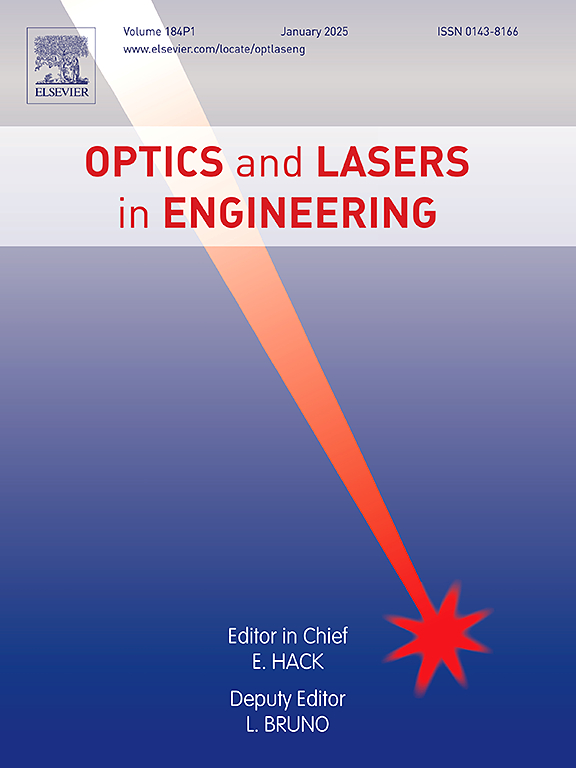采用光学配置全表面360°测量在多视图数字图像相关
IF 3.5
2区 工程技术
Q2 OPTICS
引用次数: 0
摘要
反光镜辅助多视点数字图像相关(MV-DIC)方法采用双反光镜立体视觉系统,实现对目标的360°全景测量。该方法利用两个镜像装置将物体分割成三幅图像,利用立体视觉系统独立重建。通过图像拼接实现完整的360°全景测量。然而,这种方法在成像系统的不同景深范围内同时捕获物体的所有三个表面,这带来了挑战,导致某些表面的图像不清晰和测量误差。为了解决这一问题,本研究提出了一种新的MV-DIC系统光学结构。在该系统中,一对直角棱镜在调整棱镜的位置方面起着至关重要的作用,有效地解决了在不同景深范围内实现物体不同区域的高精度成像问题。此外,为了实现高精度360°全景测量,提出了一种不同视点三维数据的全景拼接方法。实验结果表明,与传统的镜面辅助MV-DIC系统相比,该方法不仅补偿了景深差异引起的误差,而且在360°全景形貌、位移和应变测量方面具有更高的精度,为其性能提供了保证。本文章由计算机程序翻译,如有差异,请以英文原文为准。
Employing an optical configuration for full-surface 360° measurement in multi-view digital image correlation
The mirror-assisted multi-view digital image correlation (MV-DIC) method employs a stereo vision system using two mirrors to achieve 360° panoramic measurement of objects. This approach utilizes the two mirror devices to divide the object into three images, reconstructed independently using the stereo vision system. A complete 360° panoramic measurement is achieved by image stitching. However, this method poses challenges in simultaneously capturing all three surfaces of the object within the different depth of field of the imaging system, resulting in unclear images of certain surfaces and measurement errors. To address this issue, this study introduced a novel optical configuration for MV-DIC system. In this system, a pair of right-angle prisms are incorporated, which play a crucial role in adjusting the position of the prisms to effectively resolve the issue of achieving high-precision imaging of different regions of the object across varying depth of field ranges. Furthermore, to facilitate high-precision 360° panoramic measurement, a panoramic stitching method for three-dimensional data from different viewpoints is proposed. Experimental results indicated that the proposed method not only compensates for errors induced by the depth of field discrepancies but also offers superior accuracy in 360° panoramic morphology, displacement and strain measurement compared to traditional mirror-assisted MV-DIC systems, providing reassurance in its performance.
求助全文
通过发布文献求助,成功后即可免费获取论文全文。
去求助
来源期刊

Optics and Lasers in Engineering
工程技术-光学
CiteScore
8.90
自引率
8.70%
发文量
384
审稿时长
42 days
期刊介绍:
Optics and Lasers in Engineering aims at providing an international forum for the interchange of information on the development of optical techniques and laser technology in engineering. Emphasis is placed on contributions targeted at the practical use of methods and devices, the development and enhancement of solutions and new theoretical concepts for experimental methods.
Optics and Lasers in Engineering reflects the main areas in which optical methods are being used and developed for an engineering environment. Manuscripts should offer clear evidence of novelty and significance. Papers focusing on parameter optimization or computational issues are not suitable. Similarly, papers focussed on an application rather than the optical method fall outside the journal''s scope. The scope of the journal is defined to include the following:
-Optical Metrology-
Optical Methods for 3D visualization and virtual engineering-
Optical Techniques for Microsystems-
Imaging, Microscopy and Adaptive Optics-
Computational Imaging-
Laser methods in manufacturing-
Integrated optical and photonic sensors-
Optics and Photonics in Life Science-
Hyperspectral and spectroscopic methods-
Infrared and Terahertz techniques
 求助内容:
求助内容: 应助结果提醒方式:
应助结果提醒方式:


